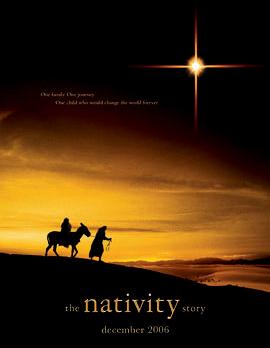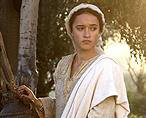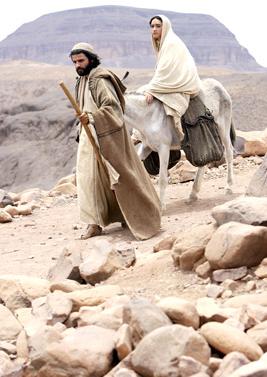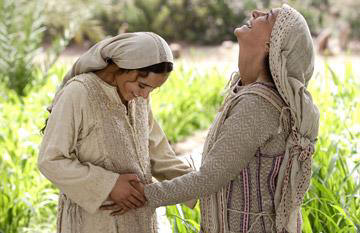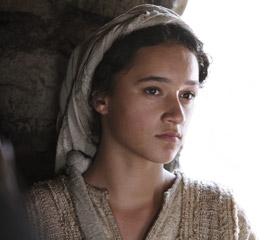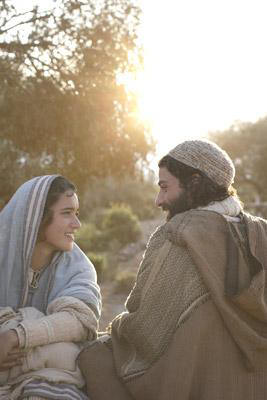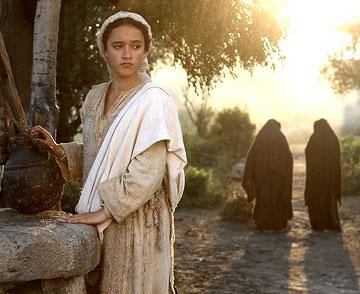Evaluating religious films
Evaluating Religious Films
The Never-Ending Challenge of Religious Films
– Father Johann G. Roten, S.M.
The recent film--not so recent anymore--The Nativity Story, with its premiere at the Vatican, has raised eyebrows and blood pressure, something a visual narrative promising peace on earth to people of good will should not promote. Though far from the prominent controversy triggered by Mel Gibson's The Passion of the Christ, the story of the Nativity seems to have maimed--according to some--still another great essential truth of Christian faith: the Virginity of Mary in partu. By the same token, the critics concluded, it reduced insidiously or unconsciously the stature of Our Lady to a textbook example of developmental psychology. Where the positive voices acclaimed the movie for its naturalness and sobriety, the negative reactions pinpointed a lack of dogmatic accuracy and overall neglect to highlight Mary's eminent grandeur.
Religious movies face and will always face a monumental challenge. Visual in essence and by obligation, they are damned if they are not making visible what escapes all visual categories. Forced to use a grammar of disclosure and visual evidence, the religious film runs up against a similarly monolithic set of rules of representation, those dealing with transcendence and mystery. The plot thickens when apparently natural phenomena, such as the birth of a child, have to be translated to cinematographic language. If such birth is miraculous and concerns the Son of God, Himself, filmmakers seem to be at the end of their ability. Is there a way to safeguard both mystery and image?
We would like to offer six criteria to evaluate religious films. In fact, it would be more accurate to speak of parameters instead of simple criteria. Of course, these parameters are no moral imperatives addressed unilaterally to filmmakers. The religious film needs to be seen as a bipartisan product, as a two-way street and thus an enlightened compromise between image and idea, a joint venture between the grammar of assent and the grammar of McLuhan. Indeed, if religion is a message in search of the adequate medium, the film operates on the promise that the medium is the message. A film will never be able to translate integrally the nuances of human thought. On the other hand, ideas are not pictures, and only rarely are we able to press the nuanced products of abstraction and deduction into patterns of imagination and narration.
(See Mike Duricy's essay for a filmographic retrospective of how nativity films of the past In Retrospective influenced more recent works.)
1. Expository and Explanatory
The religious film is in constant need of a pedagogical framework. Films like the recent Story of the Nativity present and narrate, they expound but hardly explain. True that narration is sometimes the best of explanation. However, do people spontaneously realize that the flying dove symbolizes the “overshadowing” of Mary by the Holy Spirit? Is the spectator aware that cinematographic language uses wind and light to translate the presence of God? Here is what we mean by pedagogical framework: If the visual semantics by which the movie operates are not known and explained, the spectator will be deprived of the deeper meaning of what he or she perceives. The same applies where religious symbolism is used. We are not talking about a religious pedagogy only; the pedagogical framework mentioned opts also and simultaneously for the schooling in grammar, style and the techniques proper to the seventh art. Moreover, the pedagogical process should not be limited to a purely cognitive enlightenment. Religious symbolism supported by the grammar of visual language opens not only the eye of the adept; it should likewise open his/her heart and sharpen the moral judgment. Indeed, where exposition (film) and explanation (religious meaning) complement each other, the religious film will lead to a better understanding of the nature of faith and disclose at least some of the beauty of mystery.
2. Biblical and Non-Biblical
One of the major challenges facing religious (= Christian) films is the rendering of biblical themes. We know the Bible to be a mixture of narration and instruction, whereby the narrative part mainly serves and supports the instruction. Instruction holds the essential message. However, the integral and verbatim rendering of Scripture texts, especially their instructional part, frequently tends to stifle the narrative flow of the movie. It turns out to be too solemn and rigid, has a frequent liturgical connation, and not infrequently, is too well known to elicit interest. Abandoning all together the direct reference to the Bible opens a Pandora’s box of interminable discussion about faithfulness to the sacred text and/or trivialization of its contents. Thus, attempting at least to strike a careful balance between biblical and non-biblical elements would seem to be the only viable solution. It should be the role of the non-biblical and mostly narrative elements to situate, prepare, explain and comment the sacred text, its meaning and importance. This should happen in such a way that there will be no rupture between biblical and non-biblical elements. This can be achieved by expanding the narrative part of a given scriptural episode, through a more colloquial, albeit faithful, rendering of the spoken text, and the skillful use of symbolic elements.
3. Natural and Miraculous
The religious film has to appeal to spectators living a down-to-earth existence clasped in time and space, and mostly far from miraculous events. Indeed, life frequently contrasts and clashes with the history of salvation. The Incarnation of God, the miracles of Jesus and His Resurrection cannot be understood without the reality of the miraculous. The miraculous then is an integral part of the religious movie. But how should it be represented? Filmography has developed over time a series of techniques to fill this need, for example, wind and light effects to signify the irruption of the divine in Mary's life at the Annunciation. It would seem important that the relation between this and other-worldly realities be not perceived as insurmountable clash. The distinction between "natural" and "miraculous" should as much as possible be characterized as a continuum, a combination and sequence of continuity and difference.
The miracle needs to be in tune with the natural phenomena (= continuity) to safeguard the narrative flow of the scene (for example, through a growing intensity of the wind), but it should progressively depart from a purely natural situation, for example, thanks to the voice of the angel and special light effects (= difference). The actual and bodily apparition of the angel or of Mary in Marian apparitions--often used in the past and again in the present--is a somewhat questionable and risky undertaking. Although clearly intending a visualization of the miraculous phenomenon, frequently the effect turns out to be artificial and melodramatic. For the presentation of the Annunciation it would further be important that the actress playing Mary, as the immediate recipient of the miracle, be able to express in word and gesture the transformation taking place within her. Finally, may it be said again: the presence and expression of the miraculous is essential for the religious film.
4. Narrative and Dogmatic
The reflection on the miraculous leads invariably to the delicate issue of dogma and film. Dogma ought not be sacrificed to narrative concerns, namely out of concern to present things as they are so that people can understand them. Salvation history in its very essence is deeply counter-historical, contradicting at times the very flow of human narrative. Dogma warrants this distinction and necessary opposition in order to highlight the miraculous character of the event of salvation. One of the primary functions of dogma is to express and warrant the unbreakable unity of the natural and the supernatural. The miracle to happen, for example, the Incarnation, occurs in this world, for the people of this world. Christ, the Savior and second person of the Trinity is also Jesus, the Man among "men," that is, the people of this world. There seems to be only one viable method to present the supernatural aspect of dogma. Its name is mystery. Mystery has sacred character. It is the object of awe and respect, of intuition within experimental certitude. Will filmography be able to "create mystery" in order to safeguard dogma?
The "virginity in partu," for example, is a very delicate issue, not very easy to understand for the contemporary mind, not likely to be accepted by the rationally inclined. Safeguarding the dogma, this particular dogma, means to shroud the event of Christ's birth in respect and silence, to place it within the domain of the ineffable and to surround it with an aura of mystery. This cannot be achieved by showing Mary's actual birth-giving. Cinematography would be well-advised, for example, to take inspiration from the Protogospel of James. In this apocryphal gospel the birth of Christ occurs hidden from the eyes of the world. But it is surrounded by extraordinary phenomena, such as stillness, light, and the suspension of time.
5. Historical and Universal
A religious film dealing with a timeless message needs to bring together both its historical foundation and universal significance. Recent Marian films put emphasis on Mary's Jewishness. Rightly so, because the rendering of Jewish customs and culture facilitates the understanding of the historical background of the gospels. It reinforces the realism of God's coming into the world. However, an exaggerated historicism can only be of disservice to the gospel's ultimate goal which is to be a message of good news to all people at all times. Thus, movies about Jesus and Mary should relate in word or symbol to their respective historical present. Even more important, the religious movie needs to make clear that Incarnation and Resurrection, as well as related biblical events, have universal significance. How can this be achieved cinematographically? We already pointed out the mandatory reference to the present of the spectator and the presence of salvation at all times. Of the same importance is the ever-present reality of "salvation for all."
6. Election, Vocation and Mission
One of the important contributions of religious films is to warrant psycho-spiritual realism, reflecting life and evolution, not only physically but also spiritually. Theological reading of Scripture frequently freezes persons and events into dogmatic principles and doctrinal tableaux. Virgin, Mother of God, Immaculata and Assumpta are terms designating "functions" and "figures." They sometimes let us forget that Mary was (and is) a woman, a girl, a living person, a human being in time and space. Most important, she is a person within an event, the event of salvation as this is clearly stated in the episode of the Annunciation. The latter shows that there is evolution in Mary's reaction: her election, vocation and mission from God have a human pendant leading up to the self-definition of total commitment to God: "I am the servant of the Lord."
All Marian dogmas are a human story at the outset and remain a human story in the ways of God. The religious movie has an important role to play in safeguarding the existential character of dogma. It has the technical and narrative means to make theology come alive, and thus to bring person and events in close focus and to recognize them as forms and expressions of election, vocation and mission.
All About Mary includes a variety of content, much of which reflects the expertise, interpretations and opinions of the individual authors and not necessarily of the Marian Library or the University of Dayton. Please share feedback or suggestions with marianlibrary@udayton.edu.

